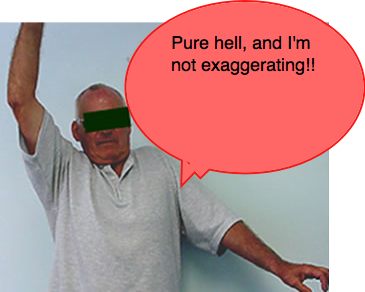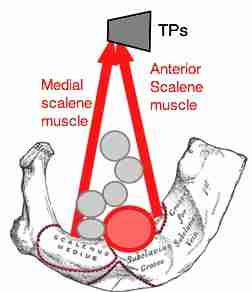Frozen shoulder treatments
This reviews of the literature for frozen shoulder treatments was reported in the American journal of occupational therapy, 2011.
Known in medical terms as an adhesive capsulitis, this is a not uncommon presenting complaint in chiropractic clinics. Having a
prevalence of about five out of every hundred adults each year, it is a clearly a condition
that warrants an investigation into how efficient and cost effective different forms of care are.
This review did not even mention NSAIDs, nor did they find one chiropractic research paper that warranted mentioning, though one study did consider mobilisation.
My own personal, unresearched opinion is that chiropractic is effective but everything is predicated on doing the exercises faithfully, and a dogged determination to avoid surgery, considering the normal course of this condition is two to four years of disability and pain. If it's only thirty percent better with manipulative care after six weeks, say, are you willing to continue?

Three phases of the UNtreated frozen shoulder
- The initial "freezing" phase lasting three to nine months.
- The extreme "frozen" phase lasting typically nine to fifteen months.
- A typical "thawing" phase lasting one and a half to two years.
Adding
that up, your untreated frozen shoulder would typically take a little
over two years at best to recover; at worst about four years.
One study (J of Shoulder and Elbow surgery) revealed that, after four years, only 6/10 patients had full function (normal or near-normal) of the shoulder. 4/10 reported some ongoing symptoms. After four years 6% still had severe pain and functional loss despite treatment.
Disabling and painful
Anyone who has worked with frozen shoulder treatments will know that Adhesive Capsulitis is one of the most painful and disabling conditions to confront the clinician. Serious sleep disturbance is the norm making the patient miserable. Dressing and undressing become extremely painful. Putting on a jacket is particularly painful.
It usually begins after some innocuous activity such as painting a ceiling or drilling above the head; looking upwards appears to be part of the cause.
Although neither anti inflammatory drugs or chiropractic had any research, this frozen shoulder page will give you some idea of the chiropractic management of this extremely painful condition that regular presents in our clinics.
Frozen shoulder treatments
Frozen shoulder treatments compares the effectiveness of conservative and surgical interventions.
1. Oral steroids
Compared with a placebo treatment, four studies found there was no long term significant improvement when measuring disability and pain reduction. One paper did reveal some temporary improvement at three weeks but, after several months, like the other three there were no significant results.
2. Cortico Steroid injections
Three RCTs found that injections into the tendon sheaths, such as the biceps or supraspinatus, the subacromial space or trigger points in muscles brought significant reduction in pain, when compared with a placebo, BUT NO INCREASE RANGE OF MOTION.
A study by Ryans reported in Rheumatology 2005 found no difference between four groups:
- corticosteroid injection into the joint plus PT
- Injection alone
- physiotherapy alone
- placebo
These medical interventions were no better than a placebo treatment.
3. Corticosteroid injections vs Physiotherapy
Six studies gave widely varying results, depending presumably on the treatment regimen and experience of the therapists.
- Four studes revealed significant benefit of injections over PT with, after two years, only external rotation still significantly reduced. PT involved therapeutic exercises or interferential current).
- One study found that injections + PT was more effective than either injections or PT alone.
- Two studies found that PT had a more beneficial effect on external rotation at four months than steroid injections.
4. Steroid injections vs Arthrographic distension
Two high quality RCTs gave contradictory results. One found that hydrodilatation gave significantly better results on the range of motion than steroid injections, the other found no difference.
Out of three studies, one found that hydrodilatation plus steroid injections was more effective than the shots alone. The other two found no difference.
One study found that hydrodilatation plus physiotherapy was more effective than PT alone.
Another
study found that manual therapy and directed exercises after
hydrodilatation was after three months significantly more effective than
sham ultrasound after hydraulic arthrographic capsular distension.
In a weak study having no controls, Piotte reported in the American J of Physical Medicine and Rehab 2004 that in a small group of fifteen patients that repeated hydrodilatation with steroid together with a home treatment for frozen shoulder programme which included exercise had a significant improvement after the first two procedures, but no further improvement thereafter.
5. Laser
Three studies report that laser therapy was more beneficial than placebo at 16 weeks (or after 15 treatments) regarding both pain and disability. Range of motion was not specifically mentioned.
However, another double blind RCT by Gingol et al (J of Photomedicine and Laser surgery, 2005) found no benefit.
6. Mobilisation plus Exercise
One high quality Randomised clinical trial found more benefit from exercise and mobilisation than exercise alone, but only in the short term.
In another, deep friction massage combined with exercise was found to be more beneficial that heat and diathermy, improving the range of motion.
High grade mobilisation was found to be slightly more effective that low grade mobilisation, both increasing mobility and lessening disability at one year.
Posterior joint mobilisation with external rotation was found to be more effective than anterior joint mobilisation.
Mobilisation at the end-range, and mobilisation with movement were found to be more effective than mid-range mobilisation at twelve weeks.
Another study found that home exercises frozen shoulder were more effective when combined with manipulation under anaesthetic, than exercises for frozen shoulder alone.
A study by Guler-Uysal and Kozanoglu (2004) provided promising results. A "Cyriax group" of 20 patients were treated with deep friction massage and joint manipulation resulting in significantly increased shoulder flexion, internal and external rotation, and pain reduction, very significantly in a decreased time compared to a standard physiotherapy group using deep and superficial heat treatments.
Vermeulen et al (2006) found that patients responded better to "high-grade" mobilisation than "low-grade" mobilisation in terms of both pain and disability over a twelve month period.
7. Acupuncture plus exercises
One high quality RCT revealed that acupuncture plus exercises was more effective than exercises for frozen shoulder treatments alone.
8. Exercises for frozen shoulder
Diercks and Stevens (J of Shoulder and Elbow surgery) compared intensive physical therapy that surpassed the pain threshold with less aggressive therapy such as active exercises within the painless range, pendulum exercises and easily tolerated activities. Those techniques that passed the pain threshold were found to be less effective. Both groups took more than a year to attain painfree full range of motion.
9. Chiropractic frozen shoulder treatments
It is of course reprehensible that Chiropractic has not produced one high quality study (assuming there was no bias in this literature search), particularly when I consider (from my humble experience) that we can do far better than any of these frozen shoulder treatments would suggest. More about that in a separate article.
Frozen Shoulder causes
* First rib fixation
A first rib fixation and associated anterior and medial scalene spasm is frequently found in an adhesive capsulitis. Key to assessing what is effectively a Thoracic Outlet syndrome is key to the effective treatment of many frozen shoulder treatments.
Adson's test, albeit subjective is the diagnostic test of choice.

* Cervical rib
Personally, I always thought a cervical rib clinically insignificant, but latterly I have changed my mind.
* Neck extension
One of the frozen shoulder causes appears to be working above the head; for example painting the ceiling or using a heavy tool. Extension of the neck closes down the foramena through which the nerves exit from the spine.
Those with known degenerative arthritis in the neck should exercise great care when looking up.
Frozen shoulder treatments: NSAIDs
No effective studies were mentioned amongst frozen shoulder treatments using NSAIDs. It would appear that there is no place for anti inflammatories (or Chiropractic!) in the management of adhesive capsulitis.
Home treatment for frozen shoulder
There are no proven home treatments but if you are simply unable to afford any treatment I would consider:
- Alternating ice and heat packs done several times a day.
- After the heat, ask a family member to massage the shoulder.
- Then do the exercises in the video above.
Did you find this page useful? Then perhaps forward it to a suffering friend. Better still, Tweet or Face Book it.
